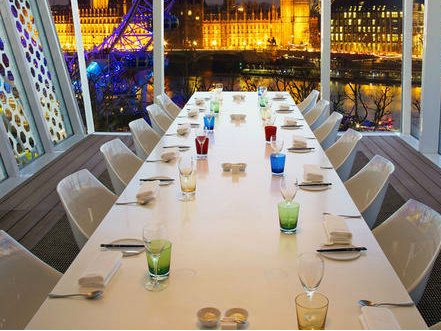(单词翻译:单击)

A couple of weeks ago, an odd message appeared on Twitter. An American food writer, sitting in a very exclusive restaurant, posted a picture of a spoon. Unlike the average tweeted food porn, this was accompanied by a plaintive request: what is this thing and what is it for? The tweeter, Kat Kinsman, is managing editor of CNN Eatocracy and she was sharing a table with a group of other high-powered foodists at a dinner honouring Thomas Keller at the time she hit "send". Kinsman has prior form with flatware, as she mentioned later: "I have an MFA [master of fine arts] degree in Metalsmithing and am always deeply amused by antiquated or single-purpose items like grape shears, lamb handles, fish knives, etcetera." The spoon, as a rapid Google search established, was a cuillère à sauce individuelle, with a flat spatula-like bowl, so sauce can be scraped from the plate without tilting it, and a notch through which any superfluous fat can drain.
几周前,Twitter上出现了一条怪信息:在一家很高档的餐馆,美国某美食作家当场在Twitter上贴出了一张勺子照片。与其它通常张贴的美食图片不一样的是:这张照片后面附了一则略带忧郁的设问:这是什么?能作何用?发照片者为CNN Eatocracy美食博客总编辑凯特•金斯曼(Kat Kinsman),点击"发送"键时,正与一伙高级美食家就坐一桌,参加给托马斯•凯勒(Thomas Keller)捧场的晚宴。金斯曼之前也曾在网上发过扁平餐具的照片,正如她事后所说:"本人获得过金属加工的美术硕士学位,一直对有年头或是功能单一的餐具(葡萄剪、羊肉手柄、食鱼刀等)情有独钟。"快速搜索一下Google网,就知道它是带有扁铲状匙底、单独舀汤用的勺子,有了它,从盘子里舀汤就不再怕倾斜,勺子上的缺口则能滤掉多余的油。
It's reassuring to a food geek, of course, that such a specialised piece of kit exists. Yet the idea that a culinary Pythia of Kinsman's stature had to connect with a worldwide network of food nerds to find out what the hell she was eating with means something is a little out of whack. As she puts it, "I felt in the presence of exceptional schmanciness."
当然,美食专家坐拥这么一件具有专门用途的餐具会显得底气十足。但一想起金斯曼这样高造诣的美食专家还得与全球的美食网民套近乎,以确认自己享用大餐所用的餐具是否上档次,这事本身就有点不正常。正如她所言:"看到如此华丽精致的餐具,感觉有点茫然不知所措。"
Any way you look at it, the use of utensils at table is culturally specific. In our own history, it was common to carry a knife in readiness for food. Only in the 17th century did the fork finally reach the English aristocracy, by way of France and Italy. Even then, it was regarded as an affectation and occasionally banned by the Church in various parts of Europe as an affront to God. The use of cutlery by ordinary people wasn't common in England until the 18th century, when cheaper methods of mass production began to make such aspirational objects more widely available.
不管怎么看待它,如何使用餐桌用具蕴含特定的文化内涵。纵观人类历史,饭前备一把刀司空见惯。直到17世纪,在法国与意大利的影响下,叉子才正式被英国贵族社会所接受。即便那时,使用叉子仍被视为做作之举,欧洲基督教会还时不时以其冒犯上帝之由发出禁令。在英国,一般民众18世纪才普遍使用餐具,成本更低的规模化生产让这种梦寐以求的餐具成为寻常百姓的日常用具。
Like pretty much everything else the English have adopted, we quickly made cutlery into a class signifier. Throughout the Georgian and Victorian periods place settings expanded with great armouries of increasingly specialised and elaborately decorated utensils. Some, such as the soup spoon – with a wide, deep bowl and offset to remain level when bringing the soup to the mouth – were fantastically useful when eating socially and sumptuously dressed. Others, such as the fish knife – supposed to be useful in separating and lifting off cooked fillets – were worse than useless and became symbolic of arriviste ostentation. Perhaps this is the root of the longstanding rumour in foodie circles that the royal household doesn't use fish knives (though they do appear at formal banquets). The Buckingham Palace press office politely "refuse to confirm or deny" this.
与英国人所接受的其它事物大同小异的是,他们很快把餐具变身为身份等级的标志。纵观整个英王乔治及维多利亚统治时期(Georgian and Victorian periods),随着分工越发明确、装饰越发精巧的餐具的出现,餐位餐具的摆放也越趋复杂。对于衣冠楚楚、但又希望有好吃相的人来说,匙底宽深、有一定弧度,能确保喝汤时仍呈水平状态的汤匙就有了大显身手的机会。其它餐具如食鱼刀——想当然地以为它方便切夹熟鱼片——则一无是处,成了暴发户卖弄的象征。这也许就是美食界一直传言王室家族不使用食鱼刀说法的由来吧,虽说它们也现身于正式宴会场合。对此说法,白金汉宫(The Buckingham Palace)新闻办公室则用"不置可否"来礼貌地做出回应。
John Betjeman's poem "How to Get on in Society" ruthlessly minces such pretensions, listing fish knives, serviettes, frills on cutlets, cruets, pastry forks and doilies. That's six references to place settings in a 20-line poem widely regarded as one of the wittier comments on the British class distinction. Let's face it, as a nation we're probably more obsessed with what's set around our plates than we are with what's on them.
在自己的诗作《如何在社交场得心应手》(How to Get on in Society)中,约翰•贝杰曼(John Betjeman)以食鱼刀、餐巾、烤肉架、调味瓶、点心叉以及桌布为例,对餐桌礼仪的细枝末节娓娓道来。在总共20行的诗句中,通过这六种东西阐述了餐位餐具的安排,被视为是对英国身份划分最为睿智的评述。我们得正视此事,因为从整体而言可能更多"沉迷"于餐盘周围的摆放,而不是在乎餐盘里摆放的东西。
The haute cuisine restaurant is the exemplar of the notion that to dine well, one must lay the table well. My chance to understand the extent of contemporary table theatre came when I was offered a place on "The Art of Fine Dining" masterclass at the three-star Alain Ducasse restaurant at The Dorchester. The dining room contains what is often billed as the most beautiful table in London, "Table Lumière", which is "surrounded by a luminescent oval curtain of 4,500 shimmering fibre optics" and equipped with what I can only describe as the Mother of All Sideboards, a floor-to-ceiling display cabinet containing the three sets of Hermès china, Puiforcat silverware and Saint-Louis crystal from which diners can select their own settings. Table Lumière also has its own separate dishwasher: that's a man, not an appliance.
要想吃好,就得讲究餐桌布置,高档餐馆是贯彻此种理念的典范。本人获邀参加在伦敦多切斯特酒店(The Dorchester)三星级餐厅艾伦•杜卡斯(Alain Ducasse)举办的名为"舌尖上的艺术"(The Art of Fine Dining)高级培训班,算是有幸了解了当代餐桌礼仪之博大精深。杜卡斯餐厅拥有一张名为Table Lumière的餐桌,被誉为是全伦敦最漂亮的餐桌,四周挂着拥有4500根闪着微光光纤的椭圆形窗帘,并配备着各种最精华餐具。在整整一面墙的陈列柜里,摆放着爱马仕(Hermès)瓷器、皮福尔卡(Puiforcat)银器以及圣路易(Saint-Loui)水晶三整套餐具,用餐者可任意组合,还配有单独的洗碗工:一位男士,而非洗碗机。
Nicolas Defrémont, the effortlessly suave restaurant director, dressed me in a brown overall and a pair of cotton gloves and took me through the process of setting one of the more ordinary tables. Table and chairs are aligned to the geometry of the room and centred under individual pools of light. The tablecloth is ironed into position. Crockery and cutlery are wheeled to the table on a special cart and polished individually, before being laid out using a complex system of measures based on the width of a finger (God help you if you don't have Michelin-approved digits). As each piece is placed relative to the last, a simple error of millimetres at the beginning of the set-up can snowball, resulting in the whole table having to be reset. Defrémont believes that a setting should actually be as simple as possible – there's no terrifying phalanx of weaponry these days. The starter instruments are laid on either side of the "show" or decorative plate and the waiter will exchange them for the correct bespoke tools according to your order.
温文尔雅的餐厅总管尼古拉•德弗雷蒙特(Nicolas Defrémont)让我穿上棕色工作服,戴上棉质手套,然后让我体验布置普通餐桌餐具的整个流程。餐桌与椅子要与房间的形状成一线,并位于各种灯具的正下方。桌布要熨烫平整后铺摆到位。器皿与餐具要用专用推车推至餐桌旁,再一件件擦亮,然后根据复杂的度量方法(由手指的宽度来确定,这是米其林星级餐厅的通行做法,若您没有手指,嘿嘿,那就没辙了)把它们摆放到位。由于餐具相互之间的摆放环环相扣,若一开始失之毫厘,最终则可能谬以千里,到头来只能推倒重来。德弗雷蒙特认为餐桌的布置实际上应尽可能简单——如今不再里三层外三层地摆放各种餐具。刚开始的餐具就摆放在装饰盘的一边,服务员会根据你所点的菜,适时把它们换成相应的专用餐具。


